If you’ve ever been house hunting, you know how difficult it is to narrow down to just one house that has everything you need.
Hardwood floors, open kitchen plans with an island and granite countertops, great backyard with room for slides and swings, close to a great school with just enough privacy but not too isolated, so help is never too far away.
Several of these factors just don’t occur simultaneously, so you usually have your minimum requirement, which comes down to security and a solid roof. Everything else is a compromise. This same idea holds true with beehive placement, too.
Beekeeping is where nature and convenience meet. So, for you to identify what beehive location would suit your bees the best, we first have to go back to nature.
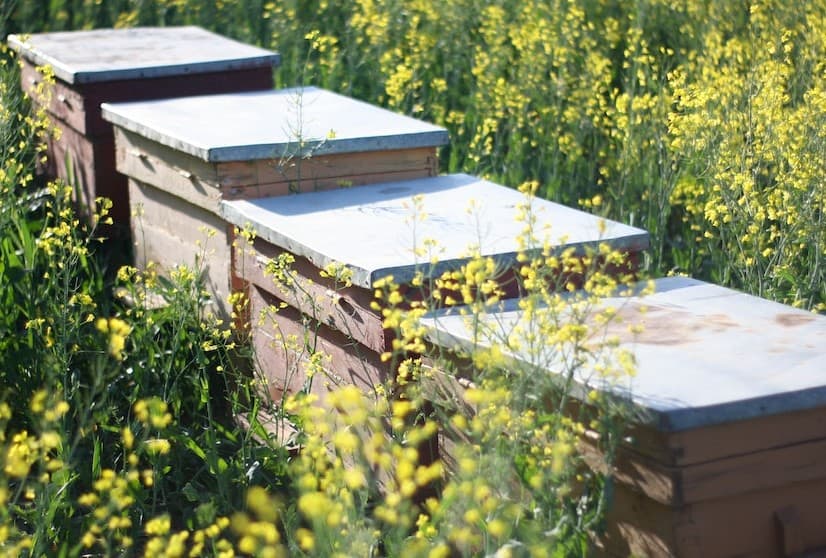
Beehive Placement Tips: Where to Place Beehives
In the wild, bees settle down and build their homes in hollowed trees or caves. What do these two places have in common?
They are both cool and remain dry, often with only one point of entry. They are above the ground, minimizing the risk of a predator reaching and destroying the hive.
This already gives us a few factors to consider regarding when (and where) we should be setting up the location of our hives.
Here are additional factors to consider when setting up the placement for a beehive.
Keep Your Hive Cool
Many people who have thousands of bee hives will put them out in the open field because that’s what works for them.
It’s pretty difficult to put up a shed to house 10,000 bee hives while ensuring that they have enough space between them.
Although these colonies survive and even thrive, that setup hive location may not be ideal, depending on where you are located.
Having a tree nearby that provides shade, especially from the afternoon sun, is a great idea. During the summer, the bees need some help keeping the hive’s interior cool.
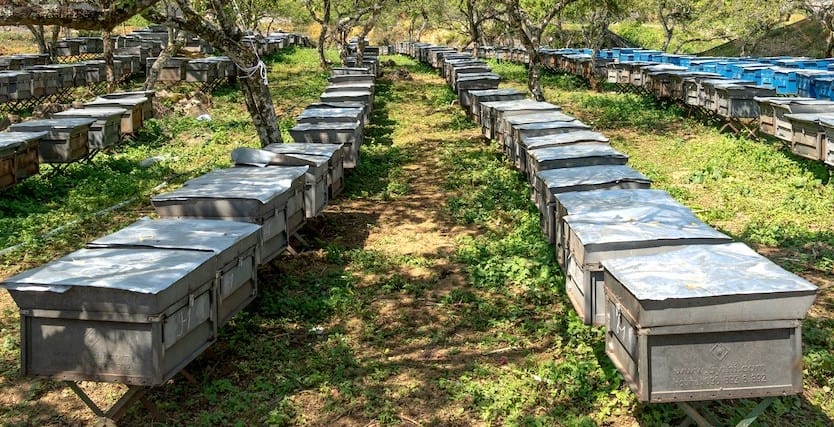
When the temperatures rise, the honey bees deposit water in the hive and evaporate the water by fanning it with their wings.
The evaporation process absorbs heat from the hive and acts as an air conditioning system. The hotter it is, the more the bees have to fan, and in some cases, you’ll find the bees forming a ‘beard’ outside the hive.
In extreme cases, the bees could abscond the bee hive altogether, especially if they are in a new colony without a brood. So, shade is definitely important.
A natural shade from a tree is ideal because the area under the tree can be cool, not cold. Whereas a shed or other man-made structures can be cold even when the temperature outside is warm.
Some level of sunlight is good for the hive. The heat from the early morning sun warms the hive and allows the bees to get off ‘blanket’ duty and begin a new day of foraging.
The bees remain in a cluster as long as the temperature in the hive is low. If your bee hive location can enjoy some morning light and then be shielded from the afternoon sun, the hive’s temperature will be easier to regulate, particularly during the hot months.
Keep Your Hive Dry
Bees like to keep a clean house, and that includes cleaning up spills. Excessive moisture in a dark warm box, which is what a hive is, can lead to mold growth, and that’s no good for your honey bees.
When you position your bee hives, ensure that no water can make its way in through an opening.
You could slant the hive slightly, with the hive entrance facing downward, to ensure that any rain that lands on the hive rolls off and away from the entrance.
If possible, you could get slanted hive covers that resemble the roof of a house. They are aesthetically pleasing and serve to direct rain away from hive entrances.
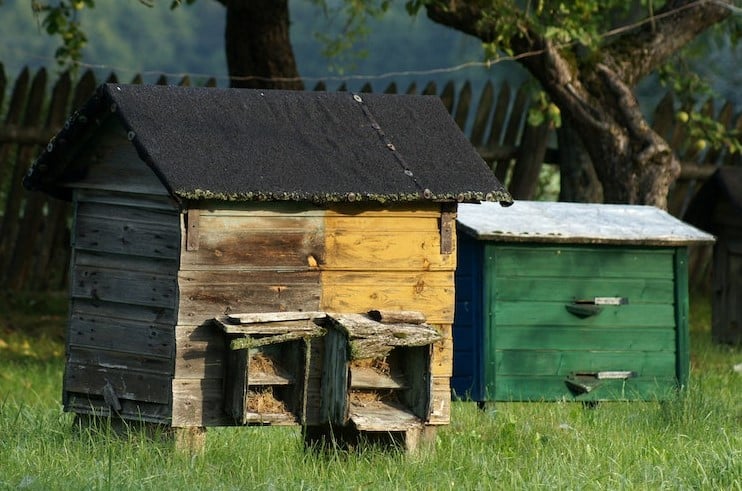
Make sure that the area around your hive drains well. If you place a beehive at the bottom of a hill, you’ll need a hive stand that’s a foot or two above the ground.
Still, on the subject of moisture, wintertime can cause an increase in moisture, leading to mold growing on the inner surface of the hive.
Fortunately, there’s a solution for this too. Good ventilation, as well as adding some wood shavings to the inner top cover, helps to keep the heat while absorbing excess moisture.
Keep Your Hive Off the Ground
There are a lot of insects and mammals that would love to get into the hive, including ants and mice.
Getting a hive stand helps to make it a little tougher for these uninvited guests to gain entry to the castle of honey.
You need to ensure that your own hive stand is stable, especially if you live in a windy area. You may need to purchase tie-downs to strap down your hive and keep it stable when the wind speeds pick up.
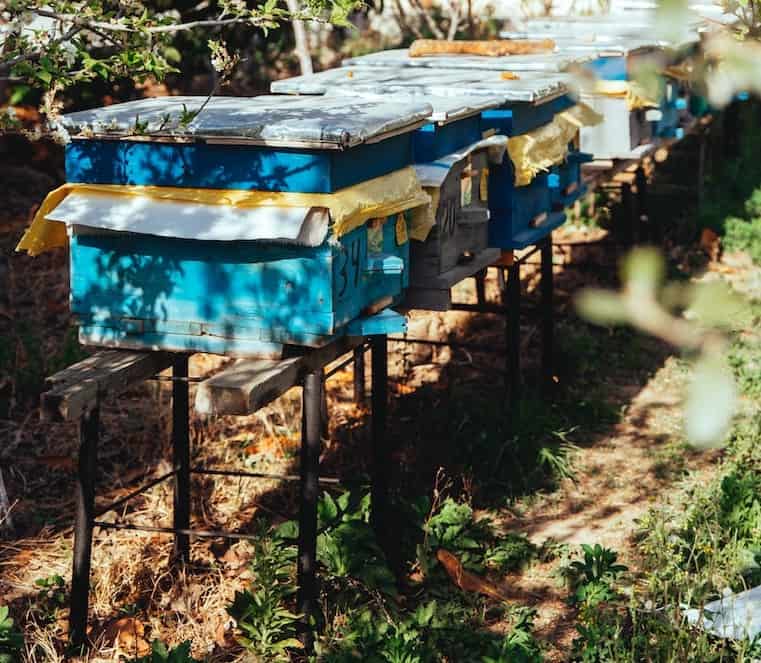
Consider the Hive’s Proximity to Water
If your neighbor has a swimming pool and no love for bees, you may find yourself on the receiving end of some angry visits and threatening messages from the neighborhood association.
Bees need water and will take it wherever they can find it. The level of chlorine does not deter them from visiting the pool.
To minimize the chances of human-bee conflict, particularly during the hot summer months, make sure your apiary location is near a good source of water. Having their own water source would keep them away from your neighbor’s pool.
It doesn’t have to be clean and fresh every day. Honey bees don’t mind stagnant murky water. What’s important is that it is safe for consumption.
Keep Your Hive in a Quiet Location
If bees wanted noise, they’d make it themselves. It’s advisable to place hives away from areas with high foot traffic that bustle with human activity.
This is especially true in urban beekeeping. In urban areas, bees are kept on rooftops for a reason. There isn’t too much going on up there, so the bees can enjoy some level of peace.
Constant noise can cause aggravation, and, in some unfortunate cases, the bees can get irritated. Another possibility is that other bees will leave the hive and never come back. This is known as absconding.
Unfortunately, you can’t choose your neighbors, and you can’t monitor their every move.
So, if you are in the immediate vicinity of a grade school, a construction site, or a very annoying teenager who is determined to jam themselves deaf to the latest hits, you may need to relocate your honey bee colony.
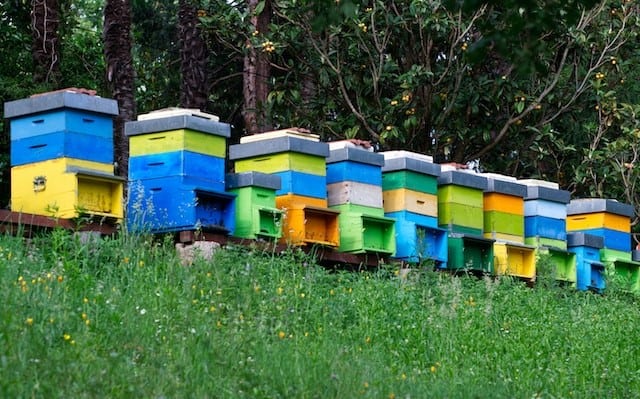
Keep the Boundaries
By forcing the bees to fly upward, you reduce the possibility of attacks. The bees, who are unable to see the passersby, do not perceive any danger and don’t get territorial by stinging potential ‘threats’ known as innocent pedestrians.
By providing a clear flight path away from people, you also protect your hives from those who are afraid of the idea of bees. I say ‘idea’ because most of these people know very little about bees and only think of them as stinging insects. They probably can’t tell the difference between a yellow jacket and a honey bee.
People with little knowledge are capable of vandalizing your hives because they are ‘dangerous.’ As long as keeping bees is not illegal in your area, the best way to deal with these types is to locate and keep the hives away from their line of sight.
Let Your Bee Hive Location Be Easily Accessible
When your bee colonies become productive, you will need to harvest honey. Honey production is a tiresome task as honey is a very heavy commodity.
When you’re adding empty supers to your hives, it’s pretty easy to do because the wood and frames are pretty light. However, doing the same at the peak of the harvest season won’t be so easy.
It would be a great benefit if you could back up your truck to within a few feet of the hives to gain easy access and make your work easier. It’s unlikely that the area will be well-paved, so a trolley will be difficult to use on the rough terrain.
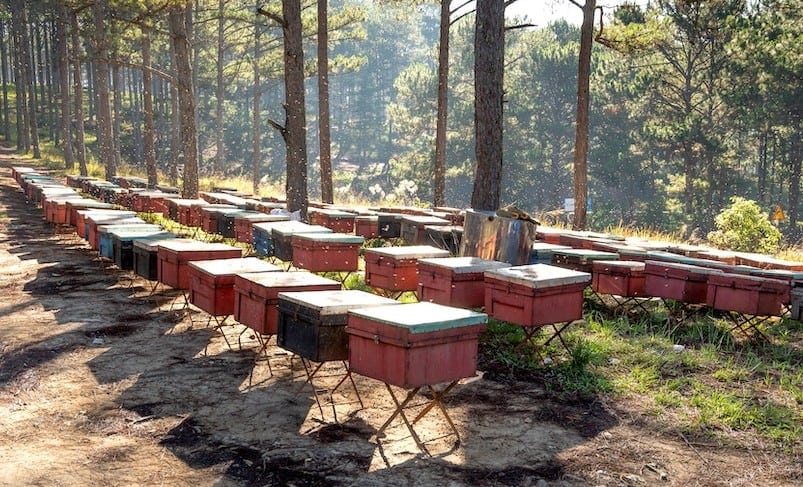
Then again, your accessibility isn’t always the priority. When setting up a bait hive to attract swarms, the recommended height of the hive from the ground is about five meters. That’s 16 ft in the air. This is according to Thomas Seeley’s ‘
Accessibility isn’t a primary factor in hive placement because this setting is temporary. Once the swarm has found its way into the bait hive and begins constructing the comb, the beekeeper will move the colony and place a beehive in a more accessible location.
Keep Your Hive Placement Away From Direct Winds
This is the second advantage of having your hive behind a fence or a hedge. The last thing you want is a strong wind toppling your hives over.
If not that, then you don’t want an icy winter wind going right through the hive entrance and chilling all the residents. For this reason, avoid having your entrance facing north.
Even when the temperatures improve, remember that a bee is a pretty small insect. Although they are quite resourceful, the wind is not an easy mistress to conquer.
When wild colonies set up their hives in trees, they already have natural windbreakers. So, when you’re considering a venue for your beehives, bear in mind the wind barrier.
Does the Perfect Bee Hive Location Exist?
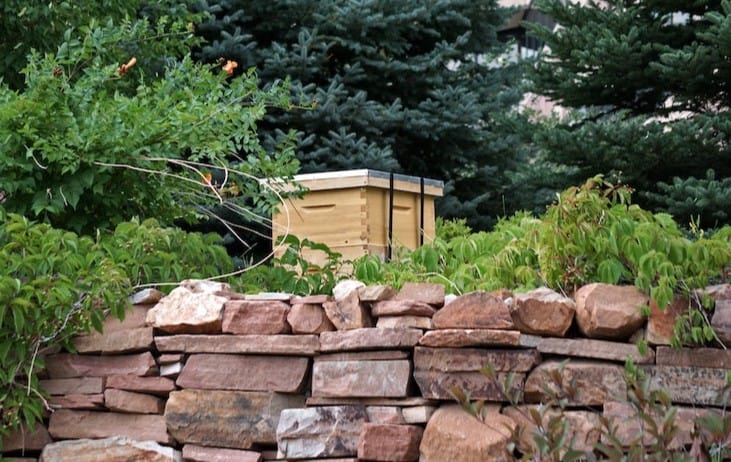
Many new beekeepers want to know where the best location to put a beehive is. Here’s what I always tell them when they ask…
Does the perfect location exist? Well, it probably does, but bees are quite adaptable, so who’s to say where that is?
If left to their own devices, bees will decide to take up residence in the ceiling of your house. Does that mean you should set a hive up there? I would think not.
In reality, most of the time, where you position your hives is guided by the options available.
A backyard beekeeper may put a hive inside the loft of a barn. Others will be fortunate to have a bubbling brook that borders their property and places the hive somewhere nearby.
Some beekeepers may put up a bee yard on a lovely meadow. All you can hear for miles around is the music of the birds and the mating calls of insects.
Under a tree where the bee hives are shaded from the full sun but still get enough dappled sunlight would also be great for your honey bees.
Depending on what nature provides, the best beehive placement could vary from one to another. Bees thrive in differing conditions and locations. What is paramount is the safety of the bees and those living in close proximity to them.
2 Additional Considerations for Ideal Beehive Placement
I don’t mean to complicate things further, but you must be aware of two other important factors when you’re deciding where to place your beehive: Pets and Spacing.
Let’s take a closer look at each and see how they impact beehive placement.
Pets

Animals, by nature, are curious creatures, and if you have a dog or cat, they may follow you out to the hives occasionally.
It would be best if your energetic dog couldn’t reach the hive, but if he does, the bees will be sure to teach him what a grave mistake that was.
There are scary stories of animals being stung to death, but most have been linked to killer bees as they migrate across the country.
Although your bees will sting your pets if they get too familiar, they probably won’t cause any fatalities.
Your dog simply won’t stick around long enough to allow that to happen. You’ll find that they are unlikely to repeat the same mistake twice anyway.
If you can keep them away, then do it, but they are unlikely to venture around there in your absence, so there’s no cause for alarm.
If you have horses nearby, you may need to put in extra effort to keep them as far from the hives as possible. Once a horse gets startled, it could easily cause injury to someone, particularly if the person is being ferried on horseback at the time.
Spacing
First of all, keep in mind that whatever space you have between hives is already contrary to nature.
I say this so you don’t spend too much time getting the measurements down to the last inch. A space of two to five feet between hives should work well.
This is mainly for your convenience. Just make sure the entrances to the hives aren’t facing each other.
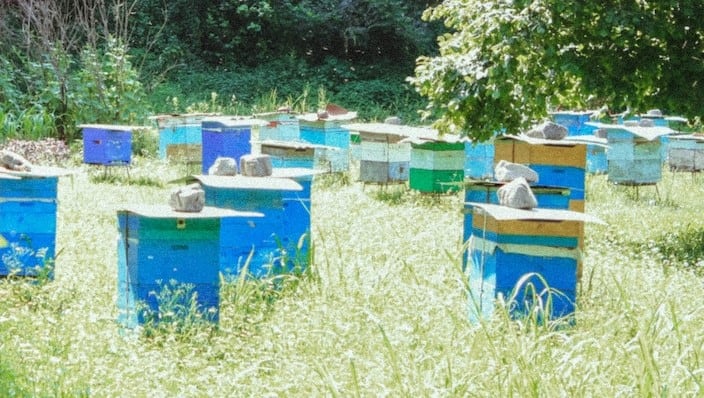
Final Thoughts on Beehive Placement
Proper placement of your beehives is essential for the health and success of your colony.
Beehive placement isn’t an exact science. As long as you’ve taken into consideration the safety of both the bees and your neighbors, the bees will be pretty happy and will flourish. Just give them a place where they feel safe.
With the basic guidelines on beehive placement we shared here, we hope that you get healthy colonies and an abundant honey harvest! Happy beekeeping!
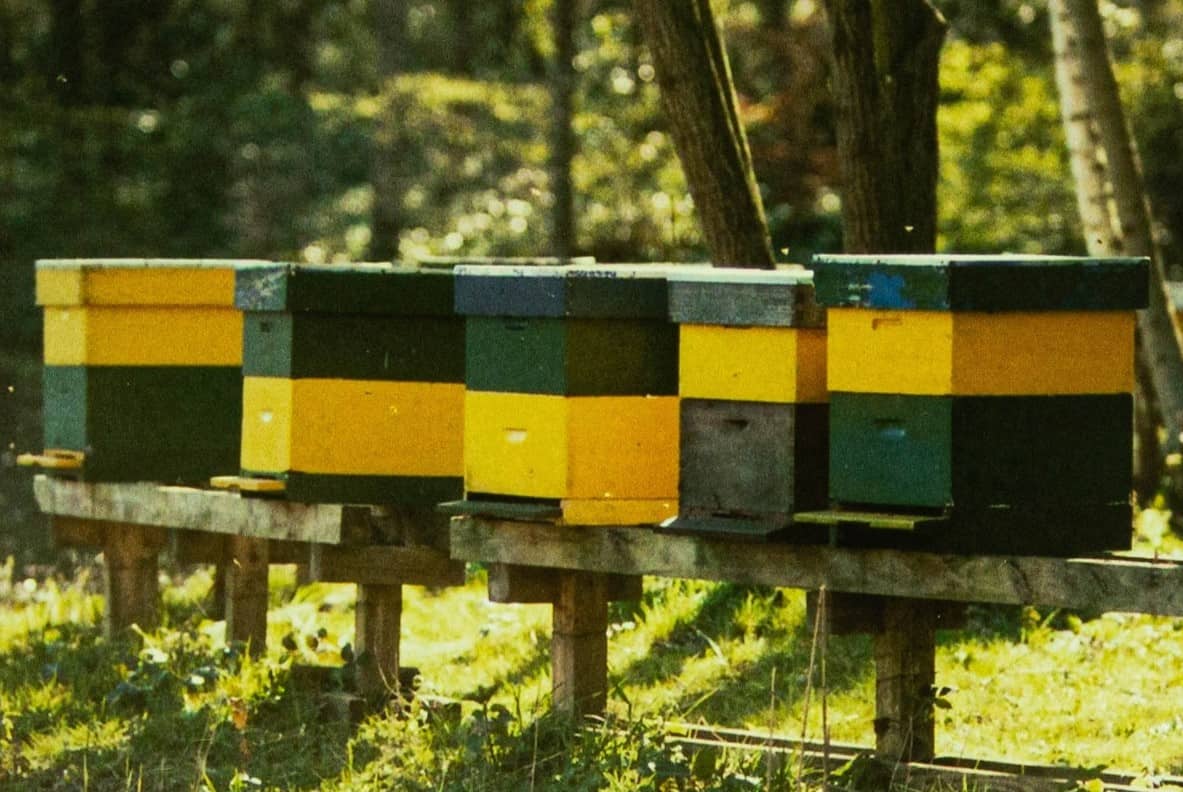
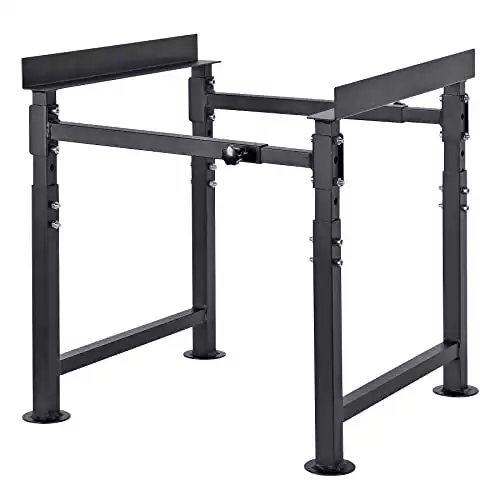

How far do bees fly to get their nectar. I live in a semi rural area with sugarcane and pineapple farms not many gumtrees and I haven’t seen many gardens with a lot of flowers. Very seldom I see a bee in our yard so would it be worthwhile to make the expense of acquiring a beehive. I don’t think sugarcane and pineapple are not very interesting for bees.
regards
Jack
Hi, a neighbor is placing 2 beehives on the other side of our 6 ft fence, 8 feet from our back patio and 12 feet from our back door (and 100 ft from his house). My wife and I own a dog who had a bad reaction to a beesting a few years back. While I’ve read that a fence can redirect bees’ flight path safely above people’s heads, we’re still concerned about the potential for swarming and overspill into our backyard. Are our concerns legitimate or unfounded?
Hi John,
I understand, but mostly your concerns are unfounded. Managed bees rarely sting anyone not associated with working the hive, especially beyond a 6 ft fence. Whilst a past sting to your dog was unpleasant, it is unfair to associate all bees including wild and sometimes aggressive strains, with the often calm and diligent selected breeds your neighbor would most likely be managing. Hopefully you can talk to the neighbor and share your concerns, please try to manage your emotions and I hope they do too. I think if people can have dogs and sure they don’t all bark, lots do, then people should be able to have bees that are calm breeds. Live and let live. Enjoy some free honey too, no doubt.
I had two hives 30’ from my house. The bees never bothered anybody. Honeybees are very docile any rarely bother people. The only time I was stung was when I got a little too close to their house with the weed wacker. The bees want nothing to do with my dogs or chickens. I wouldn’t be concerned at all. You should plant a vegetable garden and get some free pollination.
In this article on spacing your hives out you mentioned, “Don’t have the hives facing each other”. I saw a video of a Bee Keeper that had his hives in a box pattern about 5 feet apart but facing each other so he could smoke them all at once… obviously there is a reason you know or feel you should not have the hives facing each other. Can you elaborate on why you would not recommend that.
Thx,
Allen
Very compact and informative. I had the wow effect after reading this article. I couldn’t believe you could pact so much information into one article. Thanks again. Can I subscribe or get more information as Ive just started my interest in beekeeping and I’m thinking of starting my very own beekeeping business.
Christine